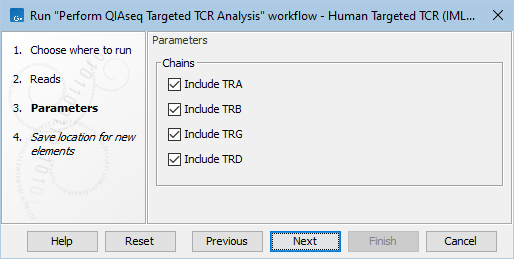Perform QIAseq Targeted TCR Analysis
Using RNA-Seq data produced with the QIAseq Targeted RNA Panel TCR Kit, the Perform QIAseq Targeted TCR Analysis workflow can be used to characterize the T cell receptor (TCR) immune repertoire. The workflow includes all necessary steps for processing the RNA-Seq reads and characterizing the repertoire:
- UMIs are removed using Remove and Annotate with Unique Molecular Index;
- Common sequence is removed using Trim Reads;
- UMI reads are created using Create UMI Reads from Reads;
- UMI reads are further quality trimmed using Trim Reads;
- Clonotypes are identified using Immune Repertoire Analysis;
- Clonotypes are filtered to remove false positives using Filter Immune Repertoire;
- Reports are combined using Create Sample Report.
To run Perform QIAseq Targeted TCR Analysis, go to the toolbox and select:
Template Workflows | Biomedical Workflows (![]() ) | QIAseq Sample Analysis (
) | QIAseq Sample Analysis (![]() ) | Other QIAseq Workflows (
) | Other QIAseq Workflows (![]() ) | Perform QIAseq Targeted TCR Analysis (
) | Perform QIAseq Targeted TCR Analysis (![]() )
)
If you are connected to a CLC Server via your Workbench, you will be asked where you would like to run the analysis. We recommend that you run the analysis on a CLC Server when possible.
Select the RNA-Seq reads in the "Select Reads" dialog. When analyzing more than one sample at the time, the Batch checkbox in the lower left corner of the dialog should be checked.
In the "Select reference data set" dialog, you need to specify the relevant Reference Data Set, see Reference data sets for immune workflows for details.
When running the workflow in Batch mode, a dialog will now appear where the batch units should be defined. See http://resources.qiagenbioinformatics.com/manuals/clcgenomicsworkbench/current/index.php?manual=Running_workflows_in_batch_mode.html for details.
The 'Minimum UMI group size' can be set in the "Create UMI Reads from Reads" dialog. Reads belonging to UMI groups supported by fewer reads than this number will be discarded. See Remove and Annotate with Unique Molecular Index and Create UMI Reads from Reads for information about UMI identification and processing.
If only specific chains have been sequenced, set 'Restrict to chains' accordingly in the "Immune Repertoire Analysis" dialog. See Immune Repertoire Analysis for more details.
In the "Filter Immune Repertoire" dialog, clonotypes supported by few UMI reads can be discarded as false positives by ticking 'Use minimum count' and setting the 'Minimum count'. See Filter Immune Repertoire for more details.
Finally, choose where to save the data, and press Finish to start the analysis.
Launching the workflow using Analyze QIAseq Samples
The Perform QIAseq Targeted TCR Analysis workflow can be launched using the Analyze QIAseq Samples guide from the Immune tab, see QIAseq sample analysis. Use Human Targeted TCR (IMLH-001) or Mouse Targeted TCR (IMLM-001Z), as appropriate.
When executing from the guide, only the sequenced chains need to be selected (figure 16.5). The remaining options are locked to their default values. .

Figure 16.5: Selecting the chains to be used for the analysis when executing the workflow from Analyze QIAseq Samples.
Subsections
